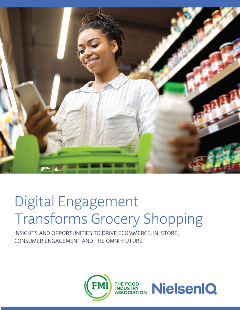Report Finds More Than 90% of Shoppers Now Purchase Groceries Both In-Store and Online
ARLINGTON, VA — As grocery shopping enters a new era of digital transformation, FMI—The Food Industry Association and NielsenIQ (NIQ) today released their new report, Digital Engagement Transforms Grocery Shopping  , which premiered at FMI’s Midwinter Executive Conference. The report finds that today, more than 90% of shoppers participate in both online and in-store shopping.
, which premiered at FMI’s Midwinter Executive Conference. The report finds that today, more than 90% of shoppers participate in both online and in-store shopping.
In 2017, FMI and NIQ predicted that by 2025, digitally engaged grocery shopper spending would reach $100 billion or 20% market penetration. This year’s report reveals that those projections were met and exceeded, with the latest FMI/NIQ projecting total U.S. online sales for grocery items to reach $388 billion or nearly 25% market penetration by 2027. It underscores the growing influence of digital tools – from ecommerce platforms and retailer apps to social media and AI-powered personalization – on the modern-day grocery shopping experience and illustrates how the COVID-19 pandemic contributed to the rapid adoption of omnichannel shopping.
“Consumers are seamlessly blending in-store and online experiences to meet their needs,” said Chief Collaboration Officer and Senior Vice President of Industry Relations for FMI, Mark Baum. “Our research underscores the urgency for food retailers and manufacturers to adapt to this omnichannel reality and leverage digital technologies to enhance convenience, personalization, and trust. Trading partners need to meet consumers where and how they want to be met."
“Digital engagement is no longer a complementary strategy, it’s essential to growth,” said Kim Cox, managing director, Omnicommerce at NielsenIQ “With online food sales projected to reach $388 billion by 2027, retailers and manufacturers must prioritize ecommerce and social commerce strategies to meet the expectations of digitally connected consumers.”
Other key findings of the report include:
- Online Sales Growth: Online sales growth exceeds that of in-store for food and nonfood categories, while in-store leads in total share.
- Youth Purchasing Power: Gen-Z begins its shopping journeys online and is heavily influenced by social media. Meanwhile, Millennials index highest for online purchasing.
- Social Media Ecommerce: Fifty-five percent of respondents now make direct purchases from social media or live-stream platforms for grocery and household items.
- Technology Prioritization: Ninety-two percent of retailers are using technology, including AI, to personalize or customize shopping or marketing experiences, both online and in-store.
- Curbside Pickup: Curbside pickup is used more often by shoppers at 31% of respondents, overtaking same-day home delivery, which has dropped to 29%.
The findings highlight both the challenges and opportunities facing food retailers and manufacturers to prioritize their connected commerce strategies. Embracing channel fluidity, which allows shoppers to move effortlessly between ecommerce, in-store, and social channels, is essential for future success.
The Digital Engagement Transforms Grocery Shopping study is part of a strategic alliance and multi-year initiative with FMI and NIQ to uncover comprehensive insights on current and future digital shopping behaviors within the food retail marketplace.
For Media:
- Members of the media may contact FMI for a gratis copy of the Digital Engagement Transforms Grocery Shopping report. Learn more and find related resources at FMI.org/Omnichannel.
###
About NIQ
NielsenIQ (NIQ) is the world’s leading consumer intelligence company, delivering the most complete understanding of consumer buying behavior and revealing new pathways to growth. NIQ combined with GfK in 2023, bringing together the two industry leaders with unparalleled global reach. Today NIQ has operations in more than 95 countries covering 97% of GDP. With a holistic retail read and the most comprehensive consumer insights—delivered with advanced analytics through state-of-the-art platforms—NIQ delivers the Full View™. www.niq.com.
 Industry Topics address your specific area of expertise with resources, reports, events and more.
Industry Topics address your specific area of expertise with resources, reports, events and more.
 Our Research covers consumer behavior and retail operation benchmarks so you can make informed business decisions.
Our Research covers consumer behavior and retail operation benchmarks so you can make informed business decisions.
 Events and Education including online and in-person help you advance your food retail career.
Events and Education including online and in-person help you advance your food retail career.
 Food Safety training, resources and guidance that help you create a company food safety culture.
Food Safety training, resources and guidance that help you create a company food safety culture.
 Government Affairs work — federal and state — on the latest food industry policy, regulatory and legislative issues.
Government Affairs work — federal and state — on the latest food industry policy, regulatory and legislative issues.
 Get Involved. From industry awards to newsletters and committees, these resources help you take advantage of your membership.
Get Involved. From industry awards to newsletters and committees, these resources help you take advantage of your membership.
 Best practices, guidance documents, infographics, signage and more for the food industry on the COVID-19 pandemic.
Best practices, guidance documents, infographics, signage and more for the food industry on the COVID-19 pandemic.
